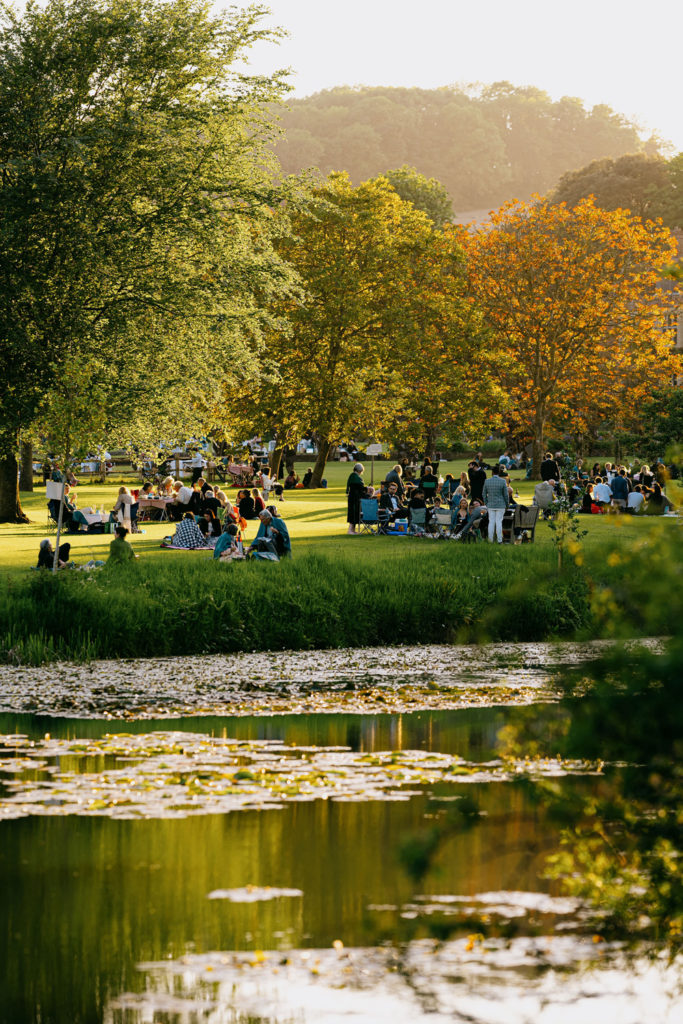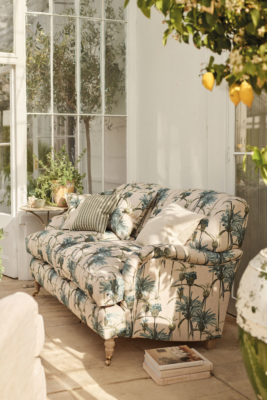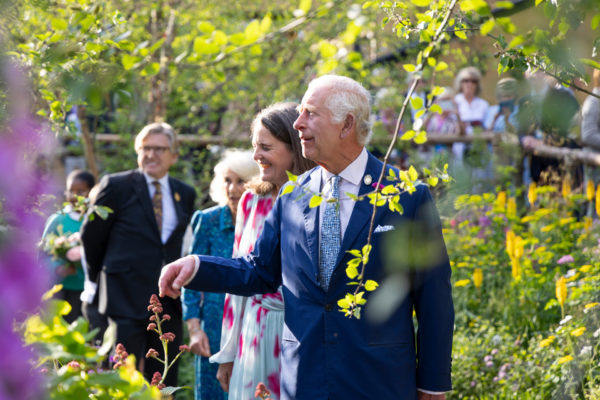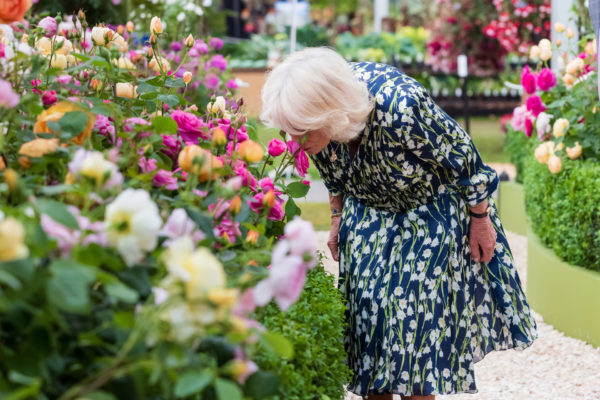A Look Back At The Chelsea Flower Show
By
10 months ago
What you might have missed this year
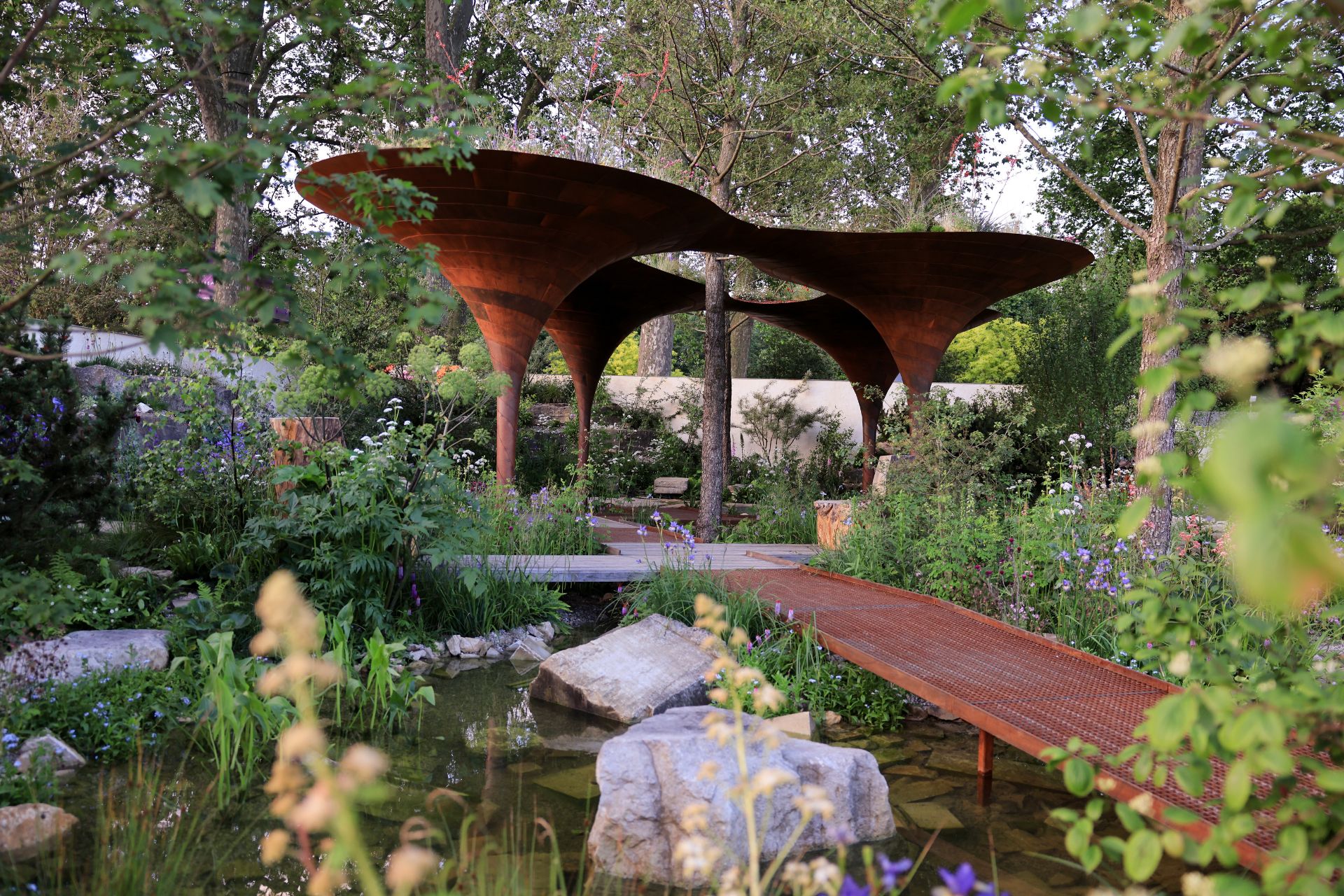
Wondering what went down at the Chelsea Flower Show this year? Wendyrosie Scott gives us a recap.
RHS Chelsea Flower Show 2024: A Recap
The Famous Plant ‘Sell-Off’
Arriving unexpectedly late on the last day of the Chelsea Flower Show without a thought for the eagerly awaited ‘plant sell-off’ was quite an awakening. As I was chatting with the Gold Medal winner, bagpipes suddenly began to play out from a high vantage point overlooking the show. Large crowds below joined in with all the musician’s renditions, singing their hearts out. As a proud Northerner with happy associations, the pipes stirred such an emotional response as only music has the powerful magnificence to do. Then a bell rang out and a live countdown began on loudspeaker, signalling the start of the ‘sell-off’. This shakedown went from nostalgic teary awe to battle of the flower buyers. Before entering the plant box-ing ring, the horticultural zealots were out in force. Many had reserved several of the stands’ display wares and arrangements, queuing to collect their pre-paid purchases, which left the remaining seekers on a mission to purchase something.
While a spirit of sharing and kindness prevailed, an abundance of high calibre and rare plant species from around the globe saw some exuberant flower enthusiasts adopt an ‘all for one and one for all’ approach. Zealot amateur gardeners surfaced, and the uplifting exotic floral scent filling the marquee became tainted by a fearless power to purchase. Talk about handbags at dawn. So when the Morrell floristry students (the sole college chosen to exhibit at this prestigious event and admired by the likes of Floella Benjamin and Mary Berry) generously announced that flowers (only) could be taken for free from their installation, the nearby visitors dissolved into a disruptive force of floral anarchy. My oh my ,Chelsea… Don’t you know this is a civilised show? At a display aptly titled ‘Awakening’, the gesture of generosity saw flowers flattened and fragile ferns quiver with terror…
More generally, though, for the six-day duration of the show, weather permitting (and the buzz not dampening even if it does/did rain), there is an air of jubilation at Chelsea Flower Show, and an immense sense of generosity in sharing ideas and sheer glee at the new, wonderful, weird and wild – plants and people alike – alongside veteran wisdom. Chelsea is buoyed by all of this.
With high expectations and chatter, Master Gardener and TV’s horticultural Godfather, Monty Don, courted controversy regarding this year’s show gardens, positing how some presentations and winners have become more like a box-ticking exercise. His fellow TV presenter agreed. There is certainly less sparkle and showmanship than in previous editions, and while there is a need for more restraint to help the environment, tempering this is a challenge for Chelsea. Let’s hope it doesn’t lose its boldness and very welcome ostentation.
Kazayuki Ishihara’s ‘Moroto No Ie’ Garden
The art of RHS veteran multi-gold award winner Kazayuki Ishihara’s gardens makes for an uplifting and enlightening installation every year. A colourful character filled with humour, his presentation is a consummate example of the nigh-on miraculous and accomplished masterworks we have come to anticipate at the RHS Chelsea generally.
This year’s garden had heart, soul and serenity. Ishihara consistently captures an elusive essence crafted in horticultural form, with an overriding aliveness particularly pertinent to moss, whose positive ecological credentials are multifold. Siberian Iris (Tropic Night), Acers and pines burst with autumnal boldness; a waterfall flows; plants soften the overall appearance; and a bridge and several tiny flowers bloom. Each represents his source of joy, as does the garden, and acts as a metaphor for the simple philosophy that when one small family lives a happy life, the whole city becomes happy, too.

WaterAid/ Oliver Dixon
The WaterAid Garden
Any Chelsea Flower Show recap isn’t complete without the WaterAid garden, which was an admirable lesson in combining aesthetically enchanting organic architecture with environmental credentials. The show’s Gold Medal Award-winning space enables adaptation in an age of serious climate change. All of this is key in the work of Tom Massey, who is regarded by many as the budding young darling of gardening, having garnered much attention over the last five years for his eco knowledge and seeming ease in applying this to a significant and unfailingly pleasing body of work. His space was created in combination with Je Ahn, a celebrated architect with an apparent art background and a fine eye for style (and substance). The duo worked wonders, resulting in a part sci-fi-looking structure. A reflection on the future of our planet and inspired by the Water Aid charity’s work in communities around the world, it considers how global warming is signalling a water crisis which even the UK is feeling the effects of, and where globally, one in 10 people are without water. The pavilion smartly filters and stores rainwater, while structurally appearing as though part of the landscape, and a rugged and rusty entity built with repurposed materials which welcomes all.
Villa Ventorum
Hailing from Northumbria, an area rich in Roman ruins and culture, the Peristyle collonaded courtyard garden, with its wild herbs and plants, deeply resonated. It was a reminder of times past, creative cultures and lives lived, in which a symbiotic relationship rooted in caring remains deeply relevant. Possessing healing and uplifting properties, its message is simple: look after the plants (and planet) and they will do the same.
Villa Ventorum was a reimagined interpretation of a noble garden in Pompeii in 78 CE, and inspired by the unearthing of a settlement on the Somerset estate which is the ‘Newts’ home. From a decorative perspective, frescoes and four sculptures created a focal point, with fountains at each corner and a water channel for rainwater collection and plant irrigation. It was a dynamic display which was so highly stylised it could have crossed to the overtly fake-looking, but it rendered archaic culture and nature with contemporary relevance, creating a serene space where myself and Chelsea’s crowds were immersed in scented splendour.
View this post on Instagram
Verdant Visions
James Whiting, a plant stylist and designer, presented another 1970s-inspired slice of nostalgia and cool. A three-time attendee and two-time Gold Medal Award winner, his style and installations make him the dandy of the house plant world. With experience in creating large-scale planting schemes for established brands, his botanical wisdom and love for enhancing spaces with plants makes for a hotly anticipated installation. With a signature eclectic style, Verdant Visions delivered a blast of colour and eclecticism to his retro dreamscape space. A timely celebration of indoor plants.
The Glasshouse Effect Studio
Another notable part of any Chelsea Flower Show recap is this display. There was something immediately joyful about it, with an atmosphere of positivity brought about by both plants and people. The studio boasts a fascinating story, beginning with the disused greenhouses of HMP East Sutton Park, which were established in 2020. It was in these studios that women in custody began their horticultural education, marking their first growing space in the prison. The original plants that the women learned to nurture are displayed densely and organised meticulously to create a crescendo of greenery, representing the women’s progress and organisation as a collective. Tin can cuttings and cups decorated with homemade crochet were utilised, while experimental seedlings and a ‘plant sick bay’ sat on shelves. High-hanging cages signified each individual working there while also holding memories outside the prison, and were rooted (pun intended) in hopes for the future. Notedly, offenders remain involved as trainers, mentors and leaders when they leave the prison. This is yet another example of the transcendent power of plants. Buoyantly – I had not known at the time of writing this – they won a Gold Medal.
View this post on Instagram
The Kitten Grayson Installation
Winner of the Floristry Ambassadors Choice Award, ‘As Above So Below. Seed to Ceiling’ was described by its creator as ‘a celebration of our inner and outer landscapes, exploring how we interact with our environment.’ Its intention, Grayson added, was to ’emphasise the importance of humans connecting with nature, nurturing our connection with our landscapes through an immersive botanical world.’ A whimsical, sustainable and artful creation filled with joy, sensitivity and authenticity.
The Anywhere Courtyard Garden
This formed part of the Balcony Gardens, designed by first-time Chelsea exhibitor and designer Elisabeth Wright-McCalla, of Botanical Spaces. The fragrant courtyard’s modular design was easily adapted to the challenges and small spaces often found in urban environs; useful bench storage and raised beds planted with medicinal herbs sat alongside scented hardy perennials which acted as seat-backs. Wright-McCalla delights in her design as a ‘place of refuge, contrast and a tranquil space of contemplation.’ The garden will be relocated to the social enterprise Create Streets, which exists to help communities, landowners, councils and developers create beautiful, healthy, and sustainable places in Grimsby.
View this post on Instagram
Days of Dahlia
Days of Dahlia is a flower farm and floristry design studio run by mother and daughter Lauren and Louisina, and their display defied its complexity. Offering an organic and sustainable approach, the pair have four decades of experience combined, and conjure arrangements whose narrative and plant life emerge from the land and seasons in their native Scotland. And while frequently harsh conditions prevail, the pair turn this to their advantage. As eco advocates at the forefront of urgently needed change in industry standards, their flowers are ‘grown not flown’. By producing and sourcing locally, their Northern credentials and creations, are a model of admiration.
The Final Word…
While Chelsea is over for another year, the RHS Forthcoming Exhibition in conjunction with Saatchi runs from from 14 June to 7 July 2024 and showcases top practitioners in the ever-expanding realm that is ‘PLANTS’. Last year’s event saw exemplary creatives with 2024 promising even more.
The Botanical Art and Photography Show is at the Saatchi Gallery, Kings Rd, London SW3 4RY. saatchigallery.com
Upcoming RHS Shows include RHS Hampton Court Palace Garden Festival (2 – 7 July, London); RHS Flower Show Tatton Park (17 – 21 July, Cheshire); and RHS Malvern Autumn Show (27 – 29 Sept, Worcester).


